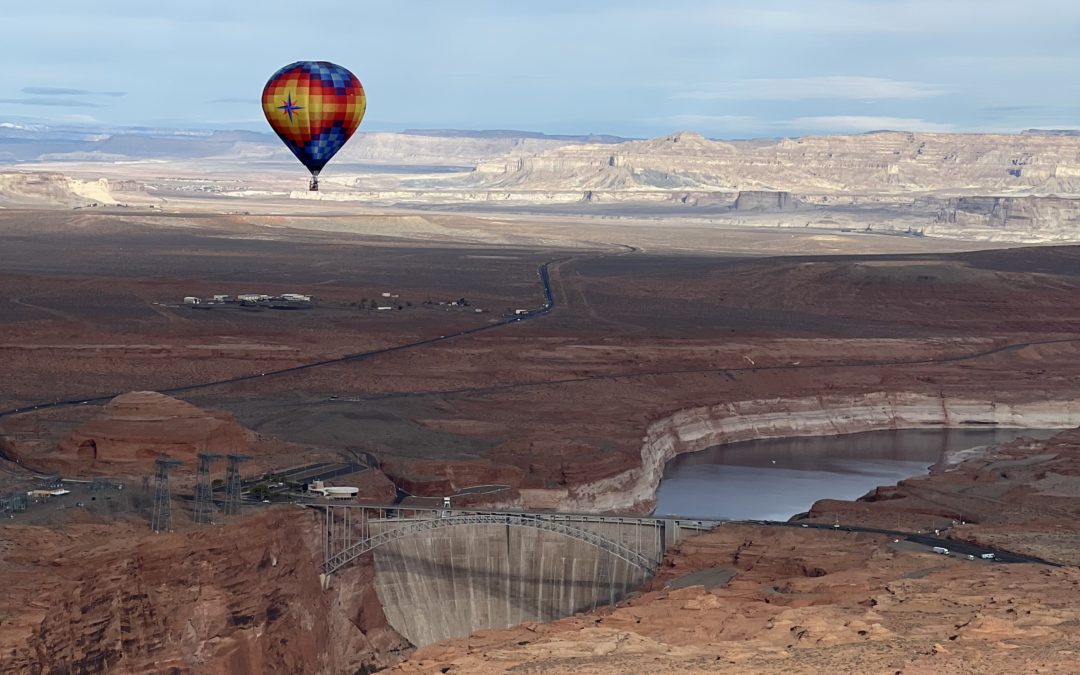Glen Canyon Dam has been in the news this last week, and these news stories identify a threat to Glen Canyon Dam that needs to be addressed. EE News, a policy-focused publication that targets the DC Beltway, broke the story. They used the headline, “Reclamation slows flows through Glen Canyon Dam to address damage.” The story was written by Jennifer Yachnin, and describes how newly discovered damage to some of the water outlet pipes of the dam could affect future operations.
The article is behind a paywall, but here is the most important part:
Reclamation officials found what is known as “cavitation damage” to the lowest level of pipes after a high-flow experiment last year, when the agency allowed larger-than-normal volumes of water to flow through the dam in order to move accumulated sediment and restore sandbars in the waterway.
This kind of damage can occur when high volumes of fast-moving water move through the dam’s spillways and pass over a rough surface, resulting in tiny bubbles of water vapor.
When those bubbles collapse, the force can damage the concrete or other material in the spillways and River Outlet Works.
“These issues are not the result of any one event,” Pullan said, noting that cavitation has occurred over time. The recent damage was seen after the high-flow experiment, however.
Pullan said the agency is concerned that low water levels in Lake Powell could cause more cavitation, a problem that the agency wants to address should it ever need to rely solely on the River Outlet Works.
While it assesses damage and considers future operations, Nick Williams, power manager for the Upper Colorado Basin Region Power Office, said Reclamation will institute temporary guidelines to reduce the flow of water through those specific outlets.
The guidelines emphasize the need to maintain Lake Powell at an elevation of at least 3,490 feet, the minimum required for hydropower production.
That level will also ensure “redundant downstream delivery of water through the penstocks and River Outlet Works if needed,” Williams said.
The Bureau of Reclamation published a Technical Memo about their plans to address this damage in the pipes, and it is best resource for understanding this situation and correcting some of the misinformation that is finding its way into news stories.
Here are some key takeaways from the memo that are important to understand:
- The Bureau of Reclamation is being proactive to address this problem.
- This damage only affected the river outlet works, which are rarely used. They were used last year for a high-flow experiment, which is when the damage occurred. Most water that flows through the dam goes through the power-generating penstocks. The penstocks are unaffected.
- BOR will only reduce flows through these outlets if water levels drop below certain levels. The lake isn’t projected to drop below these levels, so no flow reductions are projected to occur in the foreseeable future.
- The damage to the pipes from cavitation is a common problem, and it is manageable under normal historical operations of the dam.
- BOR already has plans to reline the pipes with protective coating and repair the damage that occurred. This kind of maintenance is routine.
- This discovery has encouraged the BOR to do further studies to better understand how prolonged use of the river outlet works would affect the dam, since these would need to be used extensively.
- Operating water releases through the dam at lake elevations below 3490 could create unforeseen risks, that BOR is taking measures to better understand.
As part of the Technical Memo, BOR has released updated guidelines for reducing flows through the river outlook works of the dam, if Lake Powell drops below 3550’. It is worth noting that these reduced flows only apply to the river outlet works. Water would still be able to pass through the penstocks, which is how most water flows through the dam. These reduced flows would primarily affect any high-flow experiments – not normal water releases through the dam to generate power. The lower flow guidelines would only ever apply to one of the four outlet work pipes at a time.
This table shows how flows would be reduced if the lake drops below 3550’:

On April 15, the BOR released its projections for lake levels based on updated snowpack numbers, and they do not plan for the lake to drop below 3550’ in the next 2 years. So the new guidelines are very unlikely to go into effect, but the BOR released them to be proactive and keep those who rely on the water and power informed about management decisions.
In summary, this is an entirely expected issue to occur – especially after operating the dam under extraordinary circumstances. Higher water levels that are a result of last year’s high inflows and expected strong inflows for this year, mean there is no immediate risk to the dam, its operations, or water deliveries downstream. If we have multiple years of prolonged drought that drop lake levels below 3490, the only way to release water downstream would be through the river outlet works. In that scenario these recent discoveries indicate that there would be new risks to operating the dam that BOR is working hard to better understand.
Above all, it is clear that maintaining Lake Powell at higher lake levels vastly improves almost all operating conditions for the dam, and this should be taken into account as BOR works towards finalizing its plans for its post 2026 guidelines. While we designed our Path to 3588’ plan to meet the needs of the recreation users of Lake Powell and Lake Mead, it is now becoming more clear that adopting guidelines that keep Lake Powell levels higher is better for the entire system.
Pipe Damage Isn’t the Biggest Threat to the Dam

Shortly after the BOR released its technical memo, there was a flurry of news stories like this one from British tabloid site, the Daily Mail – a “news” site that disguises news stories in a thicket of annoying display ads.
If you manage to identify the part of the website that contains “news”, what you find are a bunch of categorically false claims:
- The headline says 30m Americans could face a drinking water crisis. This is not true. At all.
- The article calls routine, expected wear and tear “major flaws in US dam.”
- It says that BOR officials said there will not be a spring release of water downstream. This is a reckless and patently false lie. There likely won’t be experimental releases, but BOR will still be meeting its legal obligations for downstream deliveries.
Here is a chart from Lake Powell Water Data showing outflows have stayed constant since the release of this news:

If you want to permanently damage your intelligence, you can go ahead and read the whole article.
However, we share this article, because it’s the most egregious example of the biggest threat to the Glen Canyon Dam. Ever since the dam was built, there have been those who have wanted to destroy it. Edward Abbey wrote a novel called the Monkey Wrench Gang about a group of radical environmentalists who plot to blow up the dam by sinking a houseboat full of explosives near the base of the dam.
This radical opposition movement evolved into a more modern movement that wants to drain Lake Powell and decommission the Glen Canyon Dam. Movements to decommission dams and remove them have been gaining momentum in recent years, and dam removals are actually occurring in the Klamath River Basin on the border of California and Oregon.
The recent low water years at Lake Powell have fed into sensational news stories about the Lake, and the fringe movement that wants to drain Lake Powell has taken advantage of this situation to get attention.
The recent news coverage of the cavitation damage to the river outlet works shows, that most reporters in the news want to perpetuate a false narrative that Lake Powell’s demise is imminent to build support for the movement that wants to drain Lake Powell and decommission Glen Canyon dam. The bias is just too obvious at this point to ignore.
The biggest threat to Lake Powell and Glen Canyon Dam isn’t repairable wear and tear to the dam’s plumbing. The engineers will fix that problem. The biggest threat to the water supply of 30 million people at the moment is a false narrative, bolstered by propaganda that the hydrological system of the Colorado River Basin can’t be sustained. Life in the arid West has always required a mix of conservation, engineering, and technology, and it will continue to require all of these things moving forward as population levels increase and resources are strained. Voluntary destruction of our infrastructure is not the answer.






